Facilitating Typhoon-Triggered Flood Disaster-Ready Information Delivery Using SDI Services Approach—A Case Study in Hainan
Abstract
1. Introduction
2. Methods and Key Design
2.1. Task-Driven Disaster Emergency Response Service Flow Model
- Earth observation data planning and acquisition: considering that the emergency government agencies usually use an internal network, the data acquisition mode from multi-source EO data centers to the broker server then to the internal data server shall be designed.
- Rapid information extraction for typhoon and rainstorm early warning: create the disaster task according to a typhoon event, automatically harvest the typhoon meteorological message data, generate the typhoon track, and evaluate the impact area, population, and base stations; meanwhile, spatial interpolation analysis is used to map the rainfall distribution based on the field observations.
- Flood inundation extraction at an interval: according to the remote sensing-based flood inundation calculation scientific model, configure the input/output parameters (e.g., processing services and data resources), invoke and run the workflow instance, and return the extraction result.
- Comprehensive impact assessment and thematic mapping: based on the flood inundation analysis results, spatial overlay analysis is used to calculate the impact on critical infrastructures and facilities; in addition, dynamic thematic mapping is carried out by combining the statistical results, area of interest, and background topographic data based on thematic map templates.
- Assessment report and decision support: an on-the-fly disaster monitoring and assessment report is generated based on the report template to support the decision-making; for the dynamic display and visualization of disaster analysis results, the thematic maps and reports are provided by using the map, list, and chart views.
2.2. Multi-Source Disaster Analysis-Ready Data (ARD) Preparation
- Multi-source disaster data acquisition and management: According to the practical requirements of the disaster management agency and duty offices, the EO, topographic, critical infrastructure, land use, demographic, and meteorological data are obtained or purchased from the Department of Homeland, Meteorology, Civil Affairs, and Water Conservancy through the corresponding automatic downloading and pipeline methods. Taking EO data as an example, the China High-Resolution Earth Observation System Gaofen satellite images [55] are automatically pushed through the exclusive internal network, while the ESA Sentinel series images are regularly downloaded through the program scripts.
- Disaster data preprocessing and ingestion: It is stated in many responses that all collected structured data, semi-structured data and unstructured data shall be tailored for analysis-ready integration and processing, or efficient map productions, which always includes (1) spatial datum unification, such as unification to the China Geodetic Coordinate System 2000 (CGCS 2000) [56]; (2) data clipping—background topographic data shall be clipped according to administrative divisions at all levels; (3) format conversion—define the conversion rules through the configuration file to convert data in batches; (4) attributes editing—modify, add, and delete data attributes as needed; (5) data index—index the data with the unified data model and determine the dimensions; (6) data representation—organize the data resources in multiple dimensions (such as space, time, resolution, subject, band, product type).
- Disaster data dissemination and access: considering both business requirements and data exchange formats, the interoperable data dissemination and access modes include (1) file access: for the small dataset with GeoJSON, XML, JPG, DOC format, it is transmitted directly as a file through the HTTP protocol; (2) database access: for dynamic data that are bound to model and processing services, a database is used for data organization and access; (3) service access: for a large amount of geographical data that need to be slice, OGC Web Map Tile Service (WMTS) and Web Feature Service (WFS) are used for data access.
2.3. Automatic Disaster Thematic Mapping and Assessment Report Generation
- Thematic mapping. This consists of a series of map templates, which record the layer styles and layout items summarized for mapping typhoon-triggered flood events based on historical data and products. Several fixed layout items include the map view with coordinate annotations, overview, title, north arrow, legend, disaster descriptions, scale bar, and credits.
- NLG. (1) Signal analysis—this detects basic patterns from the input data; for example, if the data of the typhoon track do not contain a “Landing Location” field, the GIS-based spatial analysis can be adopted to capture the landing information. Moreover, to convert the coordinates into place names, the vector dataset of country borders and the ocean base map can be used to identify the named fields. (2) Data interpretation—this infers more complex relationships between patterns and events. (3) Document planning—this arranges the paragraph structure and decides which themes to mention in the report. (4) Microplanning and realization—this generates actual texts. A template-based NLG method that combines direct mapping and rule-based aggregation is proposed to generate final texts.
- Assessment report generation. A Microsoft Word document is selected as the format of the assessment report. In the document template, body text styles, headings at all levels, tables, and figures are designed, and a header of the organization can be added.
2.4. Efficient Integrated Visualization for Decision-Ready Information
- Rapid visualization strategies. (1) Data thinning: for disaster data with complex structure, the visualization strategy for layer object instances is constructed dynamically through asynchronous analysis, extraction, and organization to improve the readability of data; (2) bidirectional incremental loading: based on user behavior prediction, the preprocessing layer objects of adjacent nodes are dynamically loaded into the 3D engine in an idle state to reduce the subsequent rendering time of predicted nodes; (3) diversified interactive process: through the color and icon mapping methods, provide the layer management and view positioning functions to support the rapid combination and visualization for different types of data (vector, grid, etc.).
- Optimization strategy for vector and grid data. (1) Unify the data to WGS84 coordinate system, and build the pyramid model based on the hierarchical organization of Quadtree Grid; (2) Since the browsers widely support GPU rendering, the rendering speed of vector data can be effectively improved by rasterizing with vertex shaders and fragment shaders.
- Browser caching mechanism for high concurrent requests. For static data files that do not need regular updates, set the cache mode to mandatory in the HTTP request header; for static data files with a short update period, set it to the negotiated cache. The browser confirms whether the cached data are expired before request: if the data are not expired, the local cache is used; otherwise, new data are requested.
3. System Implementation
3.1. Architecture Framework
- Data layer: this layer supports the discovery of and access to geographic information systems and EO data archives, to obtain the inputs needed by RDDSS to generate the decision-ready products. On the basis of SDI and interoperability standards, databases are established to provide data management, data previews, spatial queries, and metadata.
- Model layer: aiming at the comprehensive analysis and assessment of the emergency disaster response, this layer implements the processes and algorithms to support the image processing, GIS analysis, thematic assessment, and cartographic generalization functions. The distributed computing framework is also adopted to improve the processing speed and efficiency.
- Application layer: this layer supports the construction of workflow application templates for different disaster stages and different sensors, and it provides engineering modules including workflow model reuse, disaster scenario reuse, on-demand customized analysis, and disaster engineering sharing.
3.2. System Functionalities
3.2.1. Data Management Module
3.2.2. Model Service Module
3.2.3. Engineering Application Module
3.2.4. Visualization Module
3.2.5. Security Management Module
3.3. Technology Selection
3.4. Deployment Environment
4. Application Scenarios and Performance
4.1. Study Area
4.2. Fundamental Data and Indicators
4.3. Geospatial Processing Services
4.4. Use Case of Typhoon Sinlaku
4.5. Use Case of Typhoon Wipha
5. Discussion
- Key disaster-ready indicators
- Different user perspectives
- Using SDI in disaster emergency response
6. Conclusions
Author Contributions
Funding
Data Availability Statement
Acknowledgments
Conflicts of Interest
References
- Raikes, J.; Smith, T.F.; Jacobson, C.; Baldwin, C. Pre-Disaster Planning and Preparedness for Floods and Droughts: A Systematic Review. Int. J. Disaster Risk Reduct. 2019, 38, 101207. [Google Scholar] [CrossRef]
- Wu, J.; Han, X.; Zhou, Y.; Yue, P.; Wang, X.; Lu, J.; Jiang, W.; Li, J.; Tang, H.; Wang, F.; et al. Disaster Monitoring and Emergency Response Services in China. In Proceedings of the IGARSS 2018—2018 IEEE International Geoscience and Remote Sensing Symposium, Valencia, Spain, 22–27 July 2018; pp. 3473–3476. [Google Scholar]
- Chen, H.; Liang, Z.; Liu, Y.; Jiang, Q.; Xie, S. Effects of Drought and Flood on Crop Production in China across 1949–2015: Spatial Heterogeneity Analysis with Bayesian Hierarchical Modeling. Nat. Hazards 2018, 92, 525–541. [Google Scholar] [CrossRef]
- World Meteorological Organization (WMO). WMO Atlas of Mortality and Economic Losses from Weather, Climate and Water Extremes (1970–2019) (WMO-No. 1267); WMO: Geneva, Switzerland, 2021; ISBN 978-92-63-11267-5. [Google Scholar]
- Lin, L.; Di, L.; Tang, J.; Yu, E.; Zhang, C.; Rahman, M.S.; Shrestha, R.; Kang, L. Improvement and Validation of NASA/MODIS NRT Global Flood Mapping. Remote Sens. 2019, 11, 205. [Google Scholar] [CrossRef]
- Rahman, M.S.; Di, L.; Yu, E.; Lin, L.; Zhang, C.; Tang, J. Rapid Flood Progress Monitoring in Cropland with NASA SMAP. Remote Sens. 2019, 11, 191. [Google Scholar] [CrossRef]
- Phan, A.; Ha, D.N.; Man, C.D.; Nguyen, T.T.; Bui, H.Q.; Nguyen, T.T.N. Rapid Assessment of Flood Inundation and Damaged Rice Area in Red River Delta from Sentinel 1A Imagery. Remote Sens. 2019, 11, 2034. [Google Scholar] [CrossRef]
- UNDRR Annual Report. 2019. Available online: https://www.undrr.org/publication/undrr-annual-report-2019 (accessed on 16 February 2022).
- United Nations Office for Disaster Risk Reduction: 2018 Annual Report. Available online: https://www.undrr.org/publication/united-nations-office-disaster-risk-reduction-2018-annual-report (accessed on 16 February 2022).
- Lin, L.; Di, L.; Yu, E.G.; Kang, L.; Shrestha, R.; Rahman, M.S.; Tang, J.; Deng, M.; Sun, Z.; Zhang, C. A Review of Remote Sensing in Flood Assessment. In Proceedings of the 2016 Fifth International Conference on Agro-Geoinformatics (Agro-Geoinformatics), Tianjin, China, 18–20 July 2016; pp. 1–4. [Google Scholar]
- Parsons, M.; Glavac, S.; Hastings, P.; Marshall, G.; McGregor, J.; McNeill, J.; Morley, P.; Reeve, I.; Stayner, R. Top-down Assessment of Disaster Resilience: A Conceptual Framework Using Coping and Adaptive Capacities. Int. J. Disaster Risk Reduct. 2016, 19, 1–11. [Google Scholar] [CrossRef]
- Zhang, C.; Di, L.; Lin, L.; Guo, L. Machine-Learned Prediction of Annual Crop Planting in the U.S. Corn Belt Based on Historical Crop Planting Maps. Comput. Electron. Agric. 2019, 166, 104989. [Google Scholar] [CrossRef]
- OGC Disaster Pilot 2021: Call for Participation (CFP). Available online: https://portal.ogc.org/files/?artifact_id=97381 (accessed on 27 July 2021).
- OGC Invites You to Participate in Its Combined Disasters Resilience 2019 & GEOSS Architecture Implementation Pilot|OGC. Available online: https://www.ogc.org/pressroom/pressreleases/2980 (accessed on 27 July 2021).
- Sendai Framework for Disaster Risk Reduction 2015–2030. Available online: https://www.undrr.org/publication/sendai-framework-disaster-risk-reduction-2015-2030 (accessed on 16 February 2022).
- Agencies|CEOS|Committee on Earth Observation Satellites. Available online: https://ceos.org/about-ceos/agencies/ (accessed on 16 February 2022).
- Emergency|Copernicus. Available online: https://www.copernicus.eu/en/copernicus-services/emergency (accessed on 24 March 2022).
- Copernicus Emergency Management Service-Mapping. Available online: https://emergency.copernicus.eu/mapping/ (accessed on 24 March 2022).
- Global Flood Awareness System–Global Ensemble Streamflow Forecasting and Flood Forecasting. Available online: https://www.globalfloods.eu/ (accessed on 24 March 2022).
- European Drought Observatory|Copernicus. Available online: https://www.copernicus.eu/en/european-drought-observatory (accessed on 24 March 2022).
- NASA Earth Science Disasters Program. Available online: https://www.nasa.gov/centers/ames/earthscience/nasa-earth-science-disasters-program (accessed on 24 March 2022).
- Disaster Activations|NASA Applied Sciences. Available online: http://appliedsciences.nasa.gov/what-we-do/disasters/disaster-activations (accessed on 24 March 2022).
- Disaster Preparedness Program. Available online: https://response.restoration.noaa.gov/disaster-preparedness-program (accessed on 24 March 2022).
- US Department of Commerce, N. Disaster Preparedness. Available online: https://www.weather.gov/sgf/disaster_preparedness (accessed on 24 March 2022).
- NGP Emergency Response|U.S. Geological Survey. Available online: https://www.usgs.gov/ngp-user-engagement-office/ngp-emergency-response (accessed on 24 March 2022).
- Emergency Operations Portal|U.S. Geological Survey. Available online: https://www.usgs.gov/emergency-operations-portal (accessed on 24 March 2022).
- Disasters Community on GeoPlatform—Federal Geographic Data Committee. Available online: https://www.fgdc.gov/initiatives/disaster-risk-resilience/disasters-community-geoplatform (accessed on 24 March 2022).
- GeoPlatform Hub Template. Available online: https://disasters-geoplatform.hub.arcgis.com/ (accessed on 24 March 2022).
- FEMA Geospatial Resource Center. Available online: https://gis-fema.hub.arcgis.com/ (accessed on 24 March 2022).
- Yue, P.; Guo, X.; Zhang, M.; Jiang, L.; Zhai, X. Linked Data and SDI: The Case on Web Geoprocessing Workflows. ISPRS J. Photogramm. Remote Sens. 2016, 114, 245–257. [Google Scholar] [CrossRef]
- Yue, P.; Baumann, P.; Bugbee, K.; Jiang, L. Towards Intelligent GIServices. Earth Sci. Inform. 2015, 8, 463–481. [Google Scholar] [CrossRef]
- Hu, L.; Yue, P.; Zhang, M.; Gong, J.; Jiang, L.; Zhang, X. Task-Oriented Sensor Web Data Processing for Environmental Monitoring. Earth Sci. Inform. 2015, 8, 511–525. [Google Scholar] [CrossRef]
- Cheng, M.-C.; Chiou, C.-R.; Chen, B.; Liu, C.; Lin, H.-C.; Shih, I.-L.; Chung, C.-H.; Lin, H.-Y.; Chou, C.-Y. Open Data Cube (ODC) in Taiwan: The Initiative and Protocol Development. In Proceedings of the IGARSS 2019—2019 IEEE International Geoscience and Remote Sensing Symposium, Yokohama, Japan, 28 July–2 August 2019; pp. 5654–5657. [Google Scholar]
- Lacayo, M.; Rodila, D.; Giuliani, G.; Lehmann, A. A Framework for Ecosystem Service Assessment Using GIS Interoperability Standards. Comput. Geosci. 2021, 154, 104821. [Google Scholar] [CrossRef]
- Rowland, A.; Folmer, E.; Beek, W. Towards Self-Service GIS—Combining the Best of the Semantic Web and Web GIS. ISPRS Int. J. Geo-Inf. 2020, 9, 753. [Google Scholar] [CrossRef]
- Baumann, P. A General Conceptual Framework for Multi-Dimensional Spatio-Temporal Data Sets. Environ. Model. Softw. 2021, 143, 105096. [Google Scholar] [CrossRef]
- Stasch, C.; Pross, B.; Gräler, B.; Malewski, C.; Förster, C.; Jirka, S. Coupling Sensor Observation Services and Web Processing Services for Online Geoprocessing in Water Dam Monitoring. Int. J. Digit. Earth 2018, 11, 64–78. [Google Scholar] [CrossRef]
- Drost, S.; Vogt, A.; Danowski-Buhren, C.; Jirka, S.; Kirstein, V.; Pakzad, K.; Rieke, M. WaCoDiS: Automated Earth Observation Data Processing within an Event-Driven Architecture for Water Monitoring. Comput. Geosci. 2022, 159, 105003. [Google Scholar] [CrossRef]
- Di, L. Big Data and Its Applications in Agro-Geoinformatics. In Proceedings of the 2016 IEEE International Geoscience and Remote Sensing Symposium (IGARSS), Beijing, China, 10–15 July 2016; pp. 189–191. [Google Scholar]
- Mueller, M.; Pross, B. OGC WPS 2.0 Interface Standard. Version 2.0.; Open Geospatial Consortium: Rockville, MD, USA, 2015. [Google Scholar]
- OGC API. Available online: https://ogcapi.ogc.org/ (accessed on 16 February 2022).
- OGC API-Features|OGC. Available online: https://www.ogc.org/standards/ogcapi-features (accessed on 16 February 2022).
- Di, L.; Yang, Z. Foreword to the Special Issue on Agro-Geoinformatics-The Applications of Geoinformatics in Agriculture. IEEE J. Sel. Top. Appl. Earth Observ. Remote Sens. 2014, 7, 4315–4316. [Google Scholar] [CrossRef]
- Damalas, A.; Mettas, C.; Evagorou, E.; Giannecchini, S.; Iasio, C.; Papadopoulos, M.; Konstantinou, A.; Hadjimitsis, D. Development and Implementation of a DECATASTROPHIZE Platform and Tool for the Management of Disasters or Multiple Hazards. Int. J. Disaster Risk Reduct. 2018, 31, 589–601. [Google Scholar] [CrossRef]
- Sterlacchini, S.; Bordogna, G.; Cappellini, G.; Voltolina, D. SIRENE: A Spatial Data Infrastructure to Enhance Communities’ Resilience to Disaster-Related Emergency. Int. J. Disaster Risk Sci. 2018, 9, 129–142. [Google Scholar] [CrossRef]
- Rahman, M.S.; Di, L.; Yu, E.; Lin, L.; Yu, Z. Remote Sensing Based Rapid Assessment of Flood Crop Damage Using Novel Disaster Vegetation Damage Index (DVDI). Int. J. Disaster Risk Sci. 2021, 12, 90–110. [Google Scholar] [CrossRef]
- Sun, Z.; Di, L.; Gaigalas, J. SUIS: Simplify the Use of Geospatial Web Services in Environmental Modelling. Environ. Model. Softw. 2019, 119, 228–241. [Google Scholar] [CrossRef]
- Magno, R.; De Filippis, T.; Di Giuseppe, E.; Pasqui, M.; Rocchi, L.; Gozzini, B. Semi-Automatic Operational Service for Drought Monitoring and Forecasting in the Tuscany Region. Geosciences 2018, 8, 49. [Google Scholar] [CrossRef]
- Núñez-Andrés, M.A.; Lantada Zarzosa, N.; Martínez-Llario, J. Spatial Data Infrastructure (SDI) for Inventory Rockfalls with Fragmentation Information. Nat. Hazards 2022. [Google Scholar] [CrossRef]
- Tripathi, A.K.; Agrawal, S.; Gupta, R.D. A Conceptual Framework of Public Health SDI. In Proceedings of the Applications of Geomatics in Civil Engineering; Ghosh, J.K., da Silva, I., Eds.; Springer: Singapore, 2020; pp. 479–487. [Google Scholar]
- Di, L.; Eugene, G.Y.; Kang, L.; Shrestha, R.; BAI, Y. RF-CLASS: A Remote-Sensing-Based Flood Crop Loss Assessment Cyber-Service System for Supporting Crop Statistics and Insurance Decision-Making. J. Integr. Agric. 2017, 16, 408–423. [Google Scholar] [CrossRef]
- Deng, M.; Di, L.; Yu, G.; Yagci, A.; Peng, C.; Zhang, B.; Shen, D. Building an On-Demand Web Service System for Global Agricultural Drought Monitoring and Forecasting. In Proceedings of the 2012 IEEE International Geoscience and Remote Sensing Symposium, Munich, Germany, 22–27 July 2012; pp. 958–961. [Google Scholar]
- Han, W.; Yang, Z.; Di, L.; Mueller, R. CropScape: A Web Service Based Application for Exploring and Disseminating US Conterminous Geospatial Cropland Data Products for Decision Support. Comput. Electron. Agric. 2012, 84, 111–123. [Google Scholar] [CrossRef]
- Han, W.; Yang, Z.; Di, L.; Yue, P. A Geospatial Web Service Approach for Creating On-Demand Cropland Data Layer Thematic Maps. Trans. ASABE 2014, 57, 239–247. [Google Scholar] [CrossRef]
- China National Space Administration (CNSA) High-Resolution Earth Observation System. Available online: http://www.cnsa.gov.cn/ (accessed on 21 March 2022).
- United Nations China Geodetic Coordinate System 2000. Available online: https://unstats.un.org/home/ (accessed on 21 March 2022).
- Dong, C.; Li, Y.; Gong, H.; Chen, M.; Li, J.; Shen, Y.; Yang, M. A Survey of Natural Language Generation. arXiv 2021, arXiv:2112.11739. [Google Scholar]
- Cesium: The Platform for 3D Geospatial. Available online: https://cesium.com/ (accessed on 20 March 2022).
- CesiumJS: 3D Geospatial Visualization for the Web. Available online: https://cesium.com/platform/cesiumjs/ (accessed on 20 March 2022).
- JQuery: A Fast, Small, and Feature-Rich JavaScript Library. Available online: https://jquery.com/ (accessed on 20 March 2022).
- Wps-Js: A Javascript Library to Build Client Application for OGC WPS. Available online: https://wiki.52north.org/Geoprocessing/Wps-js (accessed on 20 March 2022).
- Spring Boot: An Open Source Java-Based Framework Used to Create Micro Service. Available online: https://spring.io/projects/spring-boot (accessed on 20 March 2022).
- GDAL: A Translator Library for Raster and Vector Geospatial Data Formats. Available online: https://gdal.org/ (accessed on 26 March 2022).
- MySQL: MySQL Documentation. Available online: https://dev.mysql.com/doc/ (accessed on 24 March 2022).
- PostgreSQL: Documentation. Available online: https://www.postgresql.org/docs/ (accessed on 24 March 2022).
- National Hurricane Center and Central Pacific Hurricane Center. Available online: https://www.nhc.noaa.gov/ (accessed on 20 March 2022).
- China Meteorological Administration. Available online: https://weather.cma.cn/ (accessed on 20 March 2022).
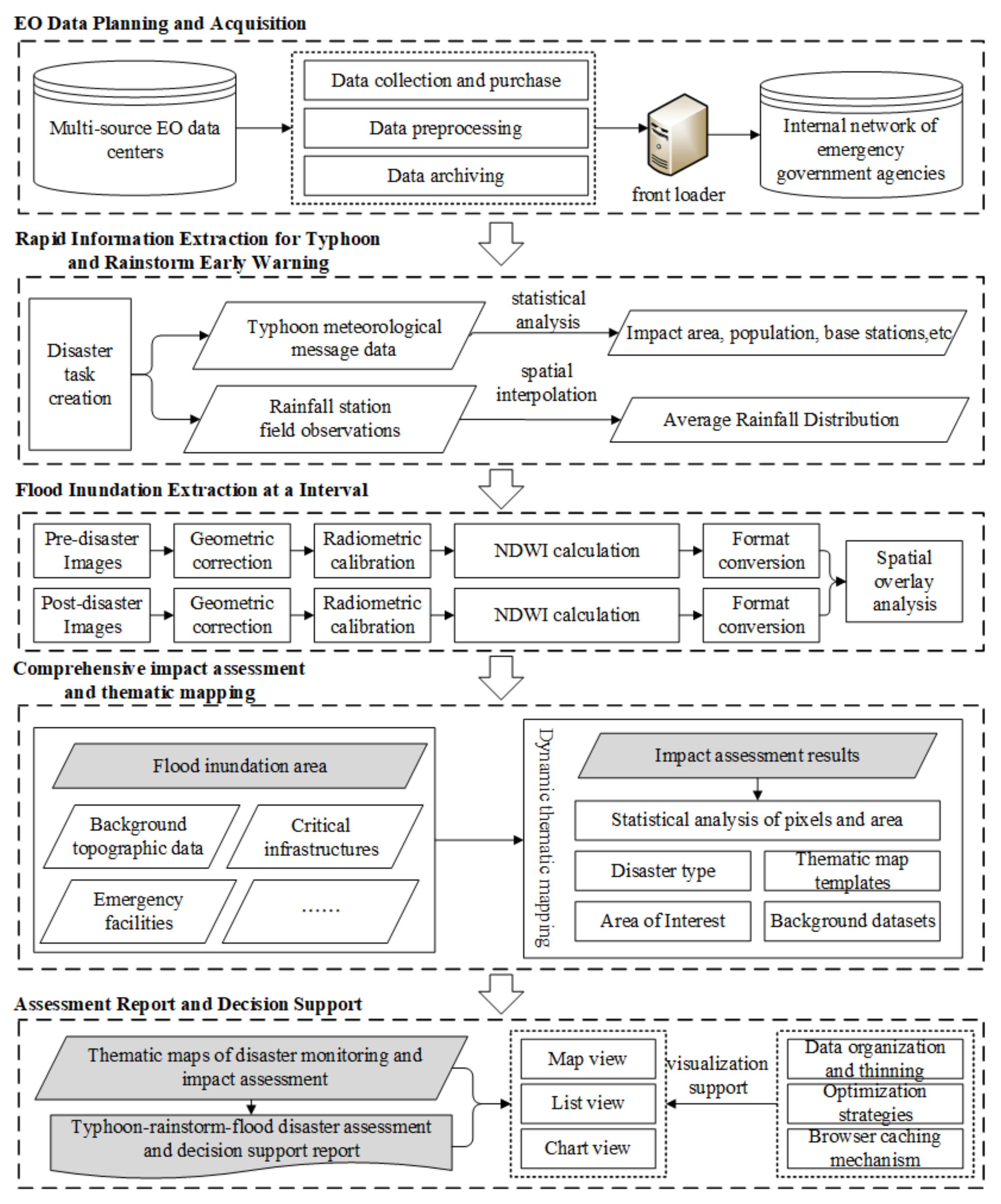
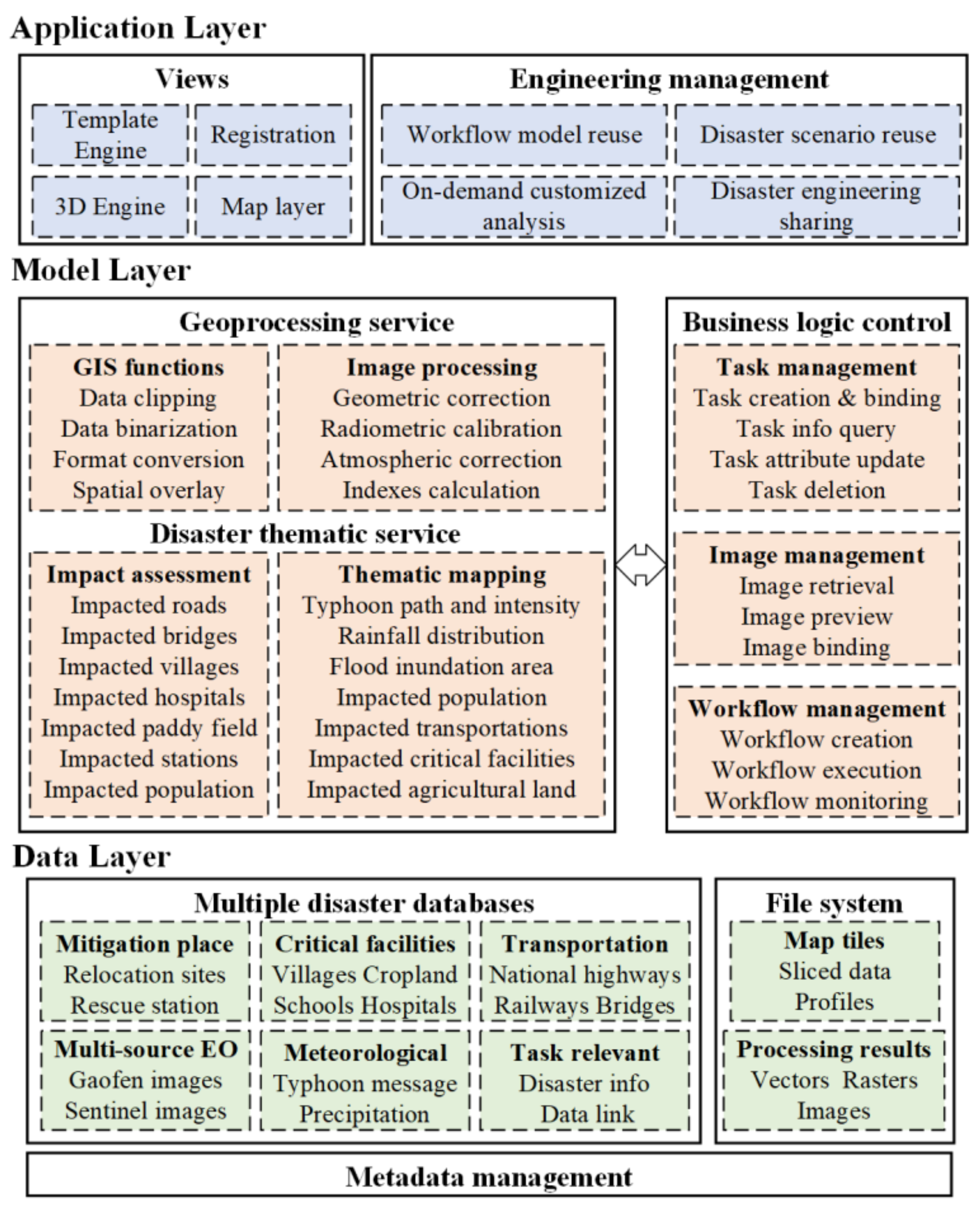
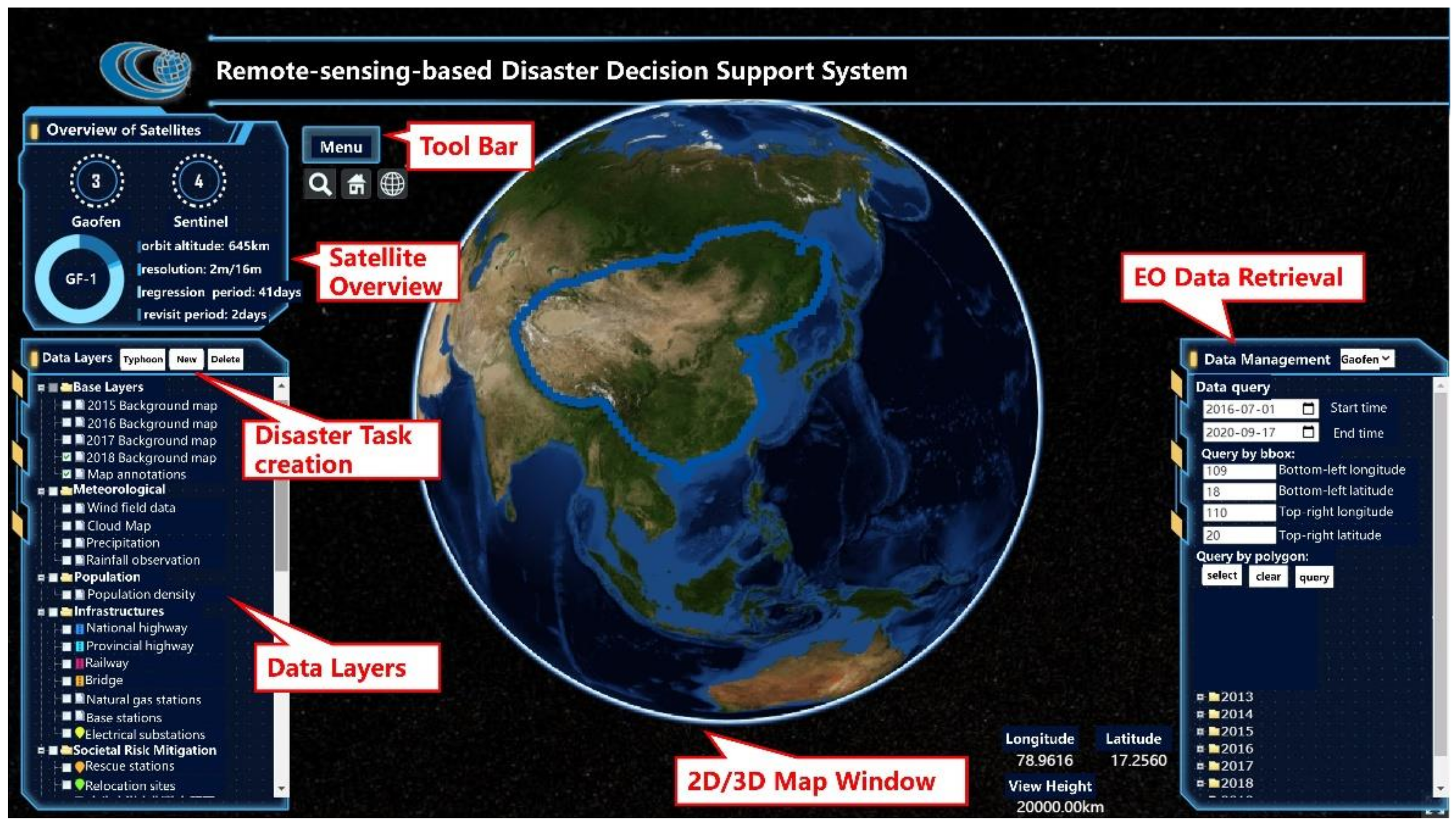


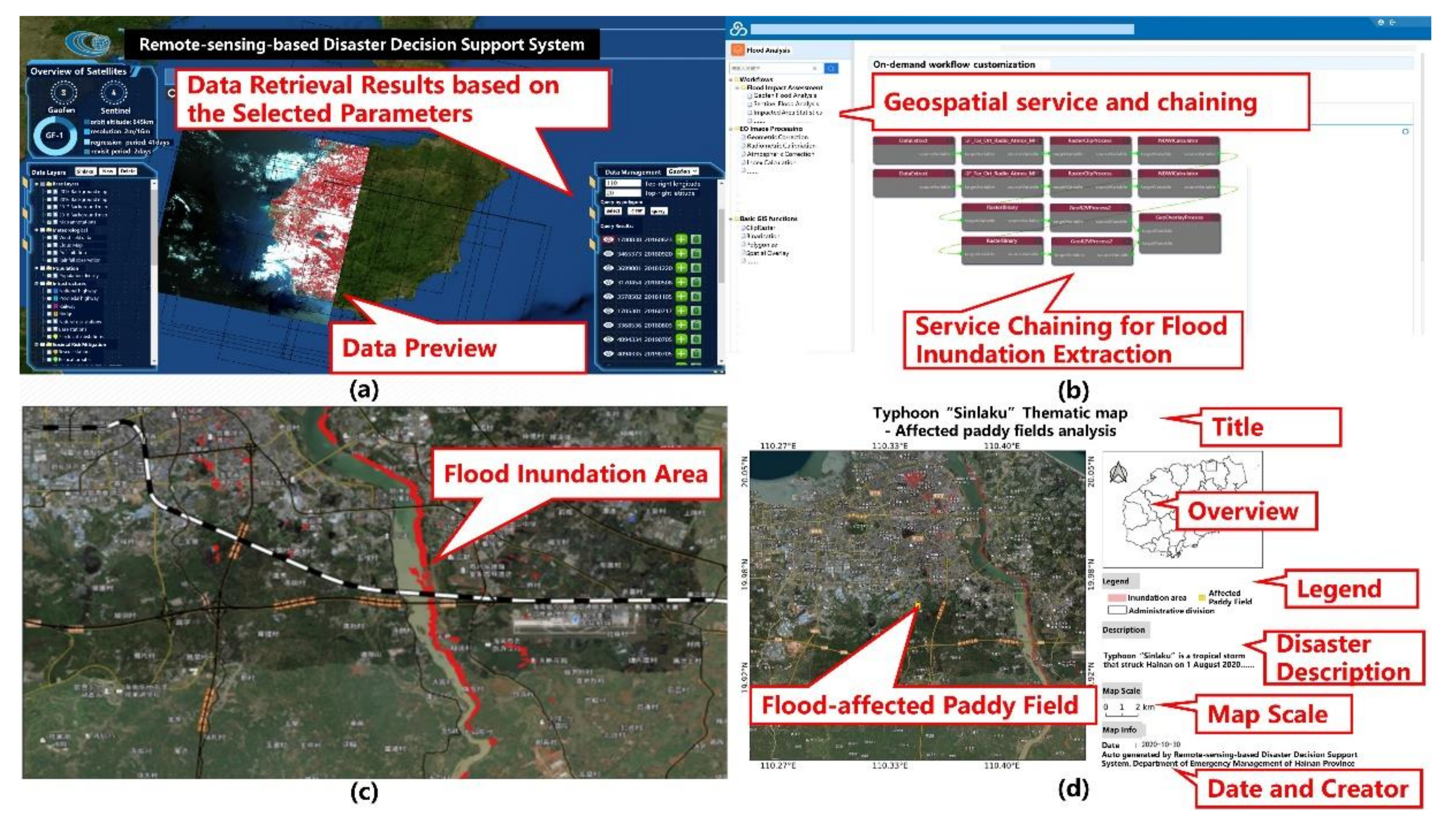
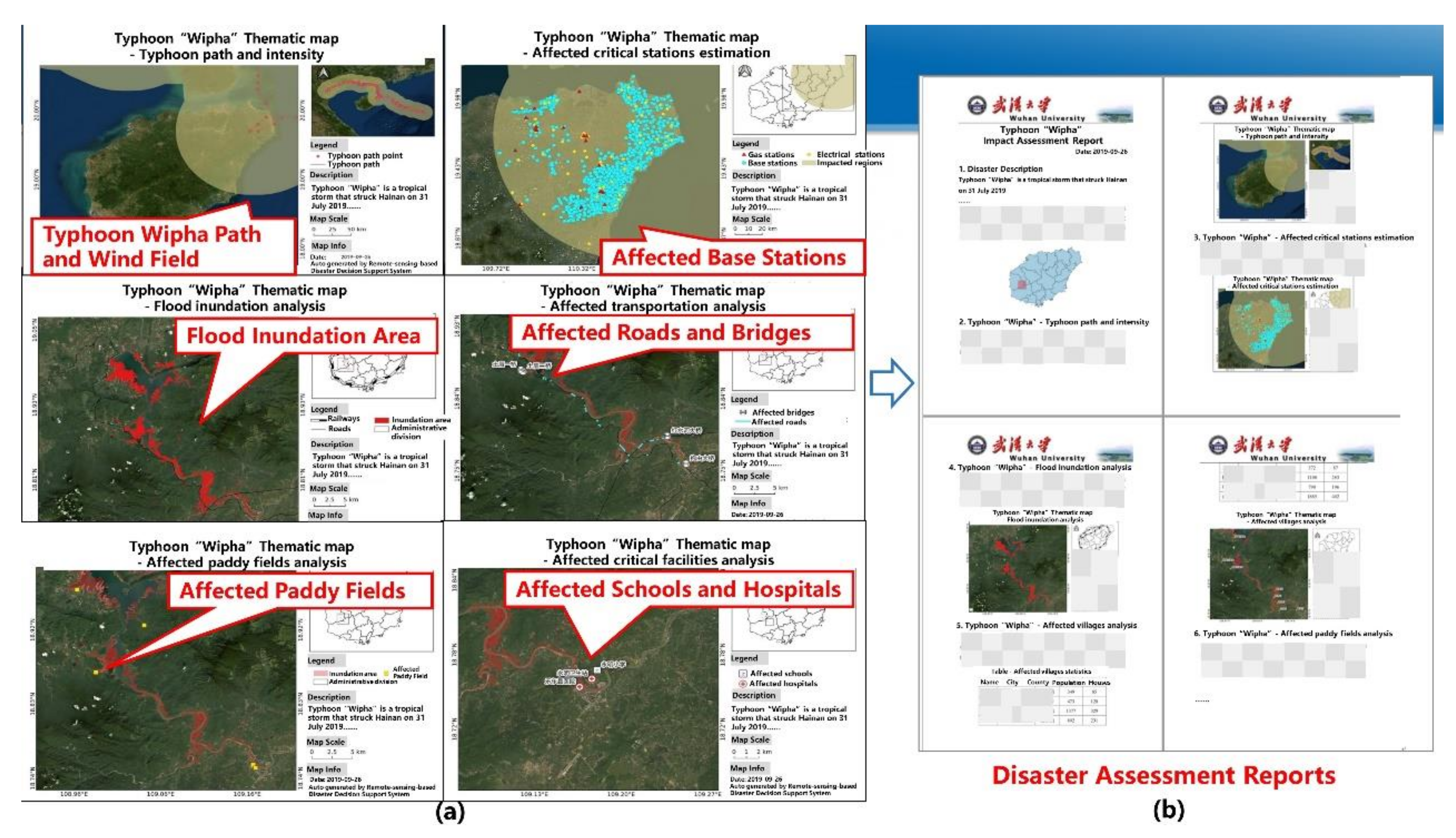
| Name | Type | Usage |
|---|---|---|
| AJAX | Asynchronous web technique | Front- and back-end data interaction, webpage dynamic modification |
| jQuery [60] | JavaScript library | HTML document traversal and manipulation, event handling |
| wps-js [61] | JavaScript library | Encoding and parsing of WPS requests and responses |
| Spring Boot [62] | Web application framework for Java platform | Creation of Spring-powered web applications and services |
| GDAL [63] | Translator library for raster and vector geospatial data formats | Utilities for data translation and processing |
| MySQL [64] | Relational database system | Store the critical facilities data, such as hospitals, base stations, rescue stations |
| PostgreSQL [65] | Relational database system emphasizing extensibility and SQL compliance | Store the geographic data |
| Decision Activities | Fundamental Data | Methods/Models | Indicators/Decision Support Products |
|---|---|---|---|
| Check the typhoon track and quickly estimate the potentially impacted regions, population, and critical facilities | Typhoon Vortex Data Message, typhoon tracking and intensity, base map, population density, distribution of critical facilities | Typhoon track generation model, rapid estimate of impacted regions and population | Near-real-time typhoon tracking and impacted area |
| Check the rainfall distribution to see which cities/areas are most affected and need potential flood analysis | Rainfall field observations, precipitation data | Geospatial interpolation analysis | Time series rainfall distribution map |
| Check the flood inundation area on a relatively large scale where the decision makers concerned | Gaofen imagery, Sentinel imagery | Flood inundation extraction model | Time series flood inundation map |
| Check the specific impacted facilities of flood disaster based on area of interest, and generate the thematic map on demand | Distribution of transportation, critical facilities, societal risk mitigation facilities, base map, flood inundation extent | Geospatial interpolation analysis, geospatial overlay analysis, geostatistical analysis, thematic mapping process | Periodic impact assessment thematic maps |
| Check the final assessment report with all thematic maps and statistical results | All the outputs of the statistics and thematic maps | Report generation process | Periodic impact assessment report |
| Type | Name | Format | Description | Source |
|---|---|---|---|---|
| Earth Observation Satellite Imagery | Gaofen-1 imagery | GeoTIFF | Optical data, 16 m spatial resolution | Hainan Data and Application Center for High-Resolution Earth Observation System, http://gfdc.hainan.gov.cn/ (accessed on 26 March 2022) |
| Gaofen-2 imagery | GeoTIFF | Optical data, 4 m spatial resolution | ||
| Sentinel-1 SAR Dataset | SAFE, GeoTIFF | SAR data, 10 m spatial resolution | European Space Agency, https://sentinels.copernicus.eu/web/sentinel/ (accessed on 26 March 2022) | |
| Sentinel-2 imagery | SAFE, GeoTIFF | Optical data, 10 m spatial resolution | ||
| Transportation | National highway | JSON | Linestring data, the national highway system and regional major roads in Hainan province | DEMHP, originally collected from the Hainan Administration of Surveying, Mapping, and Geoinformation |
| Provincial highway | ||||
| Municipal road | ||||
| Railway | ||||
| Bridge | GeoJSON | Point data, bridges in Hainan province | ||
| River | GeoJSON | Linestring data, rivers in Hainan province | ||
| Critical Facilities | Villages | GeoJSON | Point data, typical critical facilities in Hainan province | DEMHP, originally collected from the Department of Natural Resources and Planning of Hainan Province |
| Schools | ||||
| Hospitals | ||||
| Paddy fields | ||||
| Natural gas stations | ||||
| Base stations | ||||
| Electrical substations | ||||
| Societal Risk Mitigation | Rescue stations | GeoJSON | Point data, relevant societal risk mitigation places in Hainan province | DEMHP, originally from Department of Civil Affairs of Hainan Province |
| Shelters | ||||
| Relocation sites | ||||
| Geological collapse sites | ||||
| Meteorological Data | Typhoon Vortex Data Message | Text | The message contains information of latitude and longitude coordinates, intensity, wind speed, etc. | National Meteorological Center, http://www.nmc.cn/ (accessed on 26 March 2022) |
| Typhoon track and intensity | JSON | Near-real-time typhoon tracking and forecast tracking | DEMHP, provided by Hainan Meteorological Administration | |
| Precipitation | HDF5, GeoTIFF | 10 km spatial resolution | NASA Global Precipitation Measurement Mission (GPM), https://gpm.nasa.gov/data/ (accessed on 26 March 2022) | |
| Rainfall field observation | JSON | The field observation data from Hainan rainfall stations | DEMHP, published on http://zh.hainan.gov.cn/portal/ (accessed on 26 March 2022) | |
| Population | Population density | GeoTIFF | 100 m spatial resolution, estimates of numbers of people per pixel (ppp) and people per hectare (pph) | WorldPop, https://www.worldpop.org/geodata/ (accessed on 26 March 2022) |
| Base Map | Background map layer | PNG | WMTS services, background map and annotation of Hainan province | Hainan Administration of Surveying, Mapping, and GeoinformationMap World, http://lbs.tianditu.gov.cn/server/MapService.html (accessed on 26 March 2022) |
| Map annotation layer | PNG | |||
| Administrative division | GeoJSON | Linestring, the boundary files of Hainan province, cities, counties | DEMHP |
| Functionalities | WPS Services | Inputs | Outputs |
|---|---|---|---|
| Basic GIS functions | ClipRaster | Spatial extent represented by well-known text (WKT) string or GeoJSON | Clipped raster file |
| Binarization | Raster file and the threshold | Binarized raster file | |
| Polygonize | Raster file | Vector file | |
| SpatialOverlay | Two vector files | Vector file with intersected features | |
| EO Image Processing | GeometricCorrection | Image that has not been geometrically corrected | Image that has been geometrically corrected |
| RadiometricCalibriation | Image that has not been radiometrically calibrated | Image that has been radiometrically calibrated | |
| AtmosphericCorrection | Image not been radiometrically calibrated | Image that has been radiometrically calibrated | |
| IndexCalculation | Image with multiple bands | Image presenting a specific remote sensing index | |
| Disaster Impact Assessment | GetFloodInundationArea | Pre- and post-flood NDWI images | The vector layer and acreage of flood inundation area |
| GetImpactedRoads | Flood inundation and road network | The vector layer and the total length of affected roads | |
| GetImpactedBridges | Flood inundation and distribution of bridges | The vector layer and the number of affected bridges | |
| GetImpactedVillages | Flood inundation and distribution of villages | The vector layer of affected villages and the number of affected people | |
| GetImpactedHospitals | Flood inundation and distribution of hospitals | The vector layer and the number of affected hospitals | |
| GetImpactedSchools | Flood inundation and distribution of schools | The vector layer and the number of affected schools | |
| GetImpactedPaddyfields | Flood inundation and distribution of paddy fields | The vector layer and the number of affected paddy fields | |
| GetImpactedStations | Flood inundation and distribution of natural gas, base, electrical stations | The vector layer and the number of affected stations | |
| ImpactedPopulationStats | Typhoon path and intensity, wind direction and speed, population density | The number of potential affected population | |
| ImpactedAreaStats | Typhoon path and intensity, wind direction and speed, base map | The potential affected acreage of the target area | |
| Thematic Mapping | TMTyphoonPathIntensity | Real-time typhoon vortex data message or typhoon track | Thematic map of the typhoon track, forecast track, and intensity |
| TMRainfallDistribution | The field observation data of meteorological stations | Thematic map of the rainfall distribution | |
| TMFloodInundation | Reference image, flood inundation layer, and the spatial extent of the area | Thematic map of the flood inundation | |
| TMImpactedVillages | The vector layers and the numbers of affected villages and people | Thematic map of the affected villages and population | |
| TMImpactedTransportations | The vector layers and the numbers of affected roads, railways, and bridges | Thematic map of the affected transportation | |
| TMImpactedCriticalFacilities | The vector layers and the numbers of affected schools and hospitals | Thematic map of the affected critical facilities | |
| TMImpactedCropland | The vector layer and the number of affected paddy fields | Thematic map of the affected cropland | |
| Report Generation | ReportGeneration | All the outputs of the statistics and thematic maps as mentioned above, report template file | The .docx and .pdf file of disaster assessment report |
Publisher’s Note: MDPI stays neutral with regard to jurisdictional claims in published maps and institutional affiliations. |
© 2022 by the authors. Licensee MDPI, Basel, Switzerland. This article is an open access article distributed under the terms and conditions of the Creative Commons Attribution (CC BY) license (https://creativecommons.org/licenses/by/4.0/).
Share and Cite
Hu, L.; Fang, Z.; Zhang, M.; Jiang, L.; Yue, P. Facilitating Typhoon-Triggered Flood Disaster-Ready Information Delivery Using SDI Services Approach—A Case Study in Hainan. Remote Sens. 2022, 14, 1832. https://doi.org/10.3390/rs14081832
Hu L, Fang Z, Zhang M, Jiang L, Yue P. Facilitating Typhoon-Triggered Flood Disaster-Ready Information Delivery Using SDI Services Approach—A Case Study in Hainan. Remote Sensing. 2022; 14(8):1832. https://doi.org/10.3390/rs14081832
Chicago/Turabian StyleHu, Lei, Zhe Fang, Mingda Zhang, Liangcun Jiang, and Peng Yue. 2022. "Facilitating Typhoon-Triggered Flood Disaster-Ready Information Delivery Using SDI Services Approach—A Case Study in Hainan" Remote Sensing 14, no. 8: 1832. https://doi.org/10.3390/rs14081832
APA StyleHu, L., Fang, Z., Zhang, M., Jiang, L., & Yue, P. (2022). Facilitating Typhoon-Triggered Flood Disaster-Ready Information Delivery Using SDI Services Approach—A Case Study in Hainan. Remote Sensing, 14(8), 1832. https://doi.org/10.3390/rs14081832







